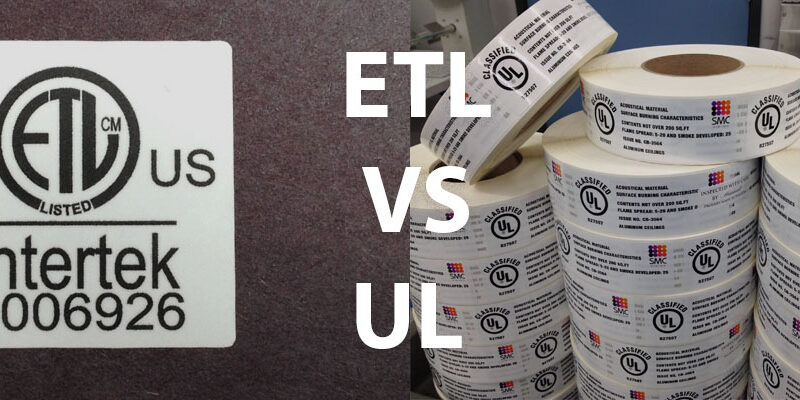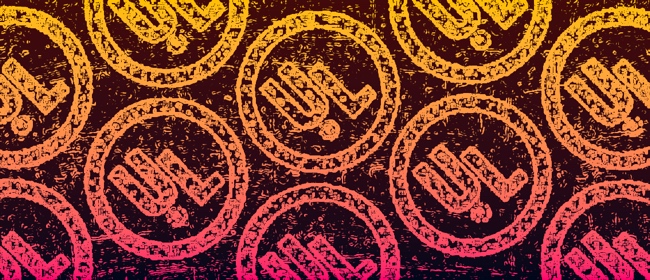If you’re wondering about the differences between ETL vs UL labels, you’re not alone. It’s commonplace to see labels like ETL Listed and UL Listed on various pieces of technology. But what do these safety labels mean? What are the differences between the different safety certifications? And what do you as a business need to do in order to earn these safety marks?
In the United States, the Occupational Safety and Health Administration, or OSHA, sets certain standards in order to ensure a workplace is safe. Some of those requirements pertain to products used by both consumers and businesses. In order to make sure users stay safe, electrical products must be certified by a Nationally Recognized Testing Laboratory or NRTL. UL, or Underwriter Laboratories, and Electrical Testing Laboratories, or ETL, are two labs in the NRTL program that test to make sure products are safe for use. Read on to learn everything you need to know about ETL vs UL labels.
What is ETL Listed?
A product that is ETL listed has been tested by ETL and verified as safe for consumer use. ETL is a member of OSHA’s Nationally Recognized Testing Laboratories, and as such, ETL’s safety standards follow those set forth by the NRTL program. Each laboratory that is part of the NRTL has its own safety mark used to show that the product has been certified to conform to safety standards. A product that has an ETL-listed label has been certified by ETL to be safe for consumer use.
What is ETL Certification?
Electrical Testing Laboratories (ETL) is the certification division of Intertek Testing Laboratories. ETL used to be Thomas Edison’s Lamp Testing Bureau, which tested the safety of lightbulbs. As the company expanded to test more electrical components for safety, the name was changed to Electrical Testing Laboratories. Today, ETL is a division of Intertek, which does quality assurance for a number of industries.
ETL certification is the process by which ETL tests products to ensure their safety. After a product has gone through ETL certification, it can be labeled with the ETL Listed label. ETL certification includes tests that make sure plastics used are self-extinguishing, fuses are present, wires are made from fire-rated materials, and so on. Additionally, after a product has been ETL certified, ETL performs surveillance on the product at certain intervals. This ensures that standards haven’t slipped. If a product no longer lives up to the safety standards ETL tests for, it will lose its ETL listing.
An ETL safety listing, or certification from another NRTL, is not legally required across the board. However, many municipalities and cities require NRTL certification before a product can be sold in that location. Obtaining an ETL certification demonstrates to your customers that your product is safe. It also ensures that your business won’t have to deal with the after costs of an unsafe product.
In order to be eligible to display the ETL listing on your product, you need to:
- Complete tests and evaluations
- Complete certification agreements
- Have a complete and successful initial factory inspection
- Receive the Authorization to Mark certificate or license.
The certification office will send you copies of the EL Listed artwork you’ll need to use. You or a printer outside of Intertek will then be able to manufacture the ETL labels for your use.
ETL Label Guidelines
Once your product is ETL listed, you are qualified to display the ETL mark on your products. In fact, using ETL labels on your products can help you establish ethos with your customers as a marketing tactic. This listing shows that you are a trustworthy business with a trustworthy product.
With the ETL safety listing comes certain rules about displaying the safety marks. An ETL label must contain the following:
- The ETL certification mark
- The control number Intertek issues to you
- Wording for the standards the product was tested to
The way you display your ETL label is ultimately up to you. Some common ways to display the ETL safety mark include adhesive labels, metal nameplates, laser etches, and stamps. You are allowed to enlarge or decrease the size of the ETL mark proportionally. One of the most important things, however, is to make sure that your ETL label is legible and visible. When included in a catalog of multiple products, you’ll need to make it clear which product has been ETL listed. Also make sure to only include ETL safety marks on products with current certification.
UL vs ETL Labels
The difference between ETL vs UL labels is minimal. In fact, ETL certification follows the same safety standards as Underwriter Laboratories or UL. Whether a product is UL listed or ETL listed, you can be sure that it conforms to high safety standards. The main difference between the two certifications is that UL develops the safety standards it tests to. ETL does not develop its own safety standards. Rather it follows those developed by UL. So, as you can see, both ETL and UL listed mean essentially the same thing.
You may be wondering which safety certification to pursue if they both follow the same safety standards. Both safety listings demonstrate to your customers that your products are safe to use. Choosing which certification to pursue is a matter of preference. Some companies opt for ETL rather than UL because ETL certification is typically quicker as well as less expensive. There are critics that say that ETL is less stringent in its testing, so some companies may choose to opt for UL certification. You might opt for ETL listing on some products and UL listing on others. Ultimately, the choice is yours.
Waterproof vs Water-Resistant Labels
UL Label Guidelines
Once your product has been evaluated and certified as conforming to UL’s safety standards, you’ll be able to place the UL safety mark on your products and marketing materials. UL has some guidelines for printing UL labels that you’ll need to follow. Your UL safety mark must have the following elements:
- UL in a circle symbol
- The word “Listed” below the symbol
- The product name
- The serial number or alphanumeric control number issued to you
UL also has an enhanced certification mark that you may opt to use. The UL enhanced and smart mark can be used for any product that has been UL certified. The enhanced UL mark shows which attributes of the product UL has certified. For example, if your product is energy efficient, the enhanced certification mark would use the word “Energy” to demonstrate that attribute. With this enhanced mark, you have the option to include a QR code so you can deliver more information to your customers in a smaller space.
In addition to UL certification, which is used for end products, UL also has a few other categories. If something is UL Recognized, this means that it is a component of a product. The component itself has been tested but has not been placed in a finished product. Some examples of products that would be UL Recognized include power supplies and circuit boards. Finally, products that are UL Classified have been certified under special conditions and with specific hazards, such as fire hazards.
NRTL vs UL
When it comes to safety standards, there are a lot of acronyms being thrown around. You might be wondering what the difference is between NRTL vs UL. NRTL stands for Nationally Recognized Testing Laboratories. Essentially, NRTLs are labs that are part of the national program under OSHA. They are from the private sector, rather than run by the government, and each NRTL has its own logo for its safety listing mark. NRTL companies keep lists of products they have certified as well as those under surveillance.
UL stands for Underwriter Laboratories. UL is just one of many testing labs in the NRTL program. One of the most distinguished testing labs, UL develops its own safety standards as well as tests products to ensure they meet those standards. Products that are UL listed are subject to further testing on a quarterly basis as part of UL’s surveillance program. If a UL-listed product no longer follows the safety standards, it will lose its UL listing and no longer be able to carry the UL label.
Getting Approved for ETL or UL Certification
The approval process for ETL or UL safety listing can be challenging. However, it’s an important part of the product development process and it helps ensure the safety of your customers. Here are some things to keep in mind when pursuing a UL or ETL safety listing:
- Research: It’s up to you to figure out whether or not your product is required to be certified by an NRTL. Reference OSHA’s list of products that require safety certification to see if yours is required. Even if not required, some products may not sell without an ETL or UL safety listing. Electrical cables, powered equipment, industrial materials, and consumer goods that present a safety risk will always need a safety listing.
- Cost: Getting your products certified by an NRTL can be expensive. Plan to spend in the thousands of dollars for the certification. And if your product is redesigned, you’ll need it to be recertified.
- Time: The certification process is lengthy. Work with your manufacturer and the safety lab together to come up with a timeline that will work for all parties.
- Documentation: There’s a lot of paperwork involved in ETL or UL certification. Some labs require specific formats, and in order to be certified, you’ll need to follow their directions exactly. Skipping steps or being vague can cost you more time because you’ll have to redo the paperwork.
ETL vs UL Labels Conclusion
Now that you know the differences between ETL vs UL labels, you’re probably ready to seek certification. Once you’ve gone through the process of getting your product certified by an NRTL, you’ll be able to label your products with a safety mark. These marks tell your customers that your products have been tested and are safe to use. You can print the safety marks in-house or opt for a label printer such as Coast Label to manufacture your ETL and UL labels. You’ll want to label your products so that your ETL and UL Listing labels are visible and easy to read. You also need to make sure the labels will adhere to your products.
At Coast Label, we can manufacture custom ETL and UL labels for your products. We’ll work with you one-on-one to engineer your ETL and UL labels to the right specifications. We can customize the size, shape, material, and adhesive your NRTL labels are made from so that your labels will stay put and remain legible. Contact Coast Label today for a free proposal.


